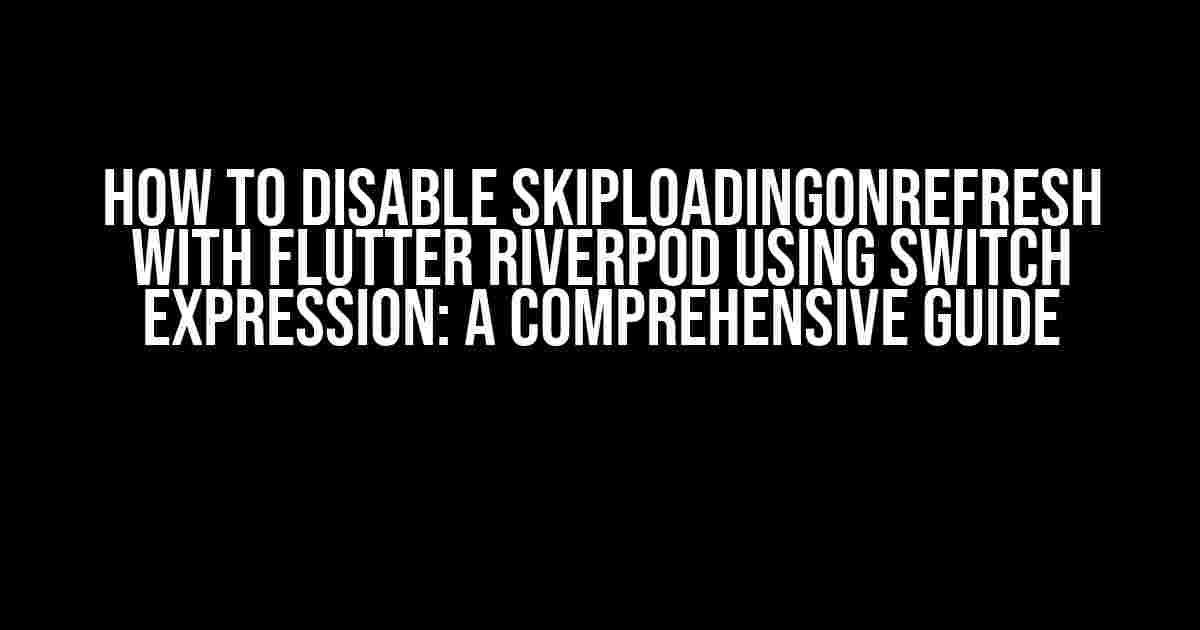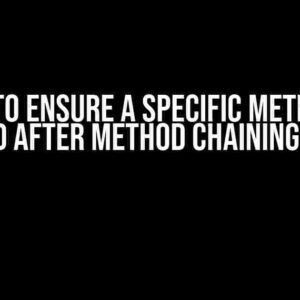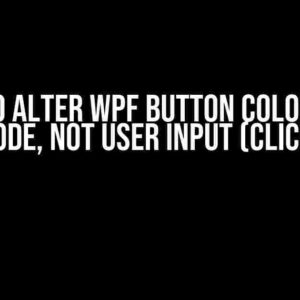Are you tired of dealing with the nuances of state management in Flutter? Do you find yourself struggling to disable the skipLoadingOnRefresh feature in Riverpod? Worry no more! In this article, we’ll take you on a journey to master the art of disabling skipLoadingOnRefresh using switch expression in Flutter Riverpod. Buckle up, folks, and get ready to dive into the world of seamless state management!
What is skipLoadingOnRefresh and Why Do We Need to Disable it?
Before we dive into the nitty-gritty, let’s understand what skipLoadingOnRefresh is and why we need to disable it. In Riverpod, skipLoadingOnRefresh is a feature that allows you to skip the initial loading of a Provider when the app is refreshed or restarted. While this feature is useful in certain scenarios, it can be problematic when you need to reload data or re-fetch data from an API upon refresh.
Imagine you’re building a social media app that fetches user data from an API. If you’ve implemented skipLoadingOnRefresh, the app will skip re-fetching the data when the user refreshes the app, resulting in outdated information being displayed. Not exactly the user experience you want to provide, right?
Why Use Switch Expression with Riverpod?
So, why do we need to use switch expression with Riverpod to disable skipLoadingOnRefresh? The answer lies in the power of Riverpod’s architecture and the flexibility of switch expressions.
Riverpod is built around the concept of Providers, which are essentially classes that hold and manage the state of your app. Providers can be combined using the `MultiProvider` widget to create a hierarchical state management system. However, when it comes to disabling skipLoadingOnRefresh, we need a more fine-grained approach.
That’s where switch expressions come in! Switch expressions allow us to dynamically toggle the skipLoadingOnRefresh feature based on specific conditions or states. By combining Riverpod with switch expressions, we can create a robust and flexible state management system that adapts to the needs of our app.
The Code: Disabling skipLoadingOnRefresh using Switch Expression
Now that we’ve covered the why, let’s dive into the how! Here’s an example code snippet that demonstrates how to disable skipLoadingOnRefresh using a switch expression with Riverpod:
import 'package:flutter/material.dart';
import 'package:riverpod/riverpod.dart';
// Define a Provider for our user data
final userDataProvider = Provider((ref) {
// Initialize the Provider with some initial data
return UserData(initialData: []);
});
// Define a switch expression to toggle skipLoadingOnRefresh
final skipLoadingOnRefreshProvider = Provider((ref) {
final userData = ref.watch(userDataProvider);
return ref.watch(switchExpressionProvider);
});
final switchExpressionProvider = Provider((ref) {
final appState = ref.watch(appStateProvider);
return appState == AppState.refresh ? false : true;
});
final appStateProvider = Provider((ref) {
return ref.watch(navigatorProvider).appState;
});
final navigatorProvider = Provider((ref) {
// Initialize the navigator with a initial app state
return NavigatorAppState(appState: AppState.normal);
});
enum AppState { normal, refresh }
In this example, we define four Providers: `userDataProvider`, `skipLoadingOnRefreshProvider`, `switchExpressionProvider`, and `appStateProvider`. The `userDataProvider` holds the user data, while the `skipLoadingOnRefreshProvider` toggles the skipLoadingOnRefresh feature based on the `switchExpressionProvider`.
The `switchExpressionProvider` uses a switch expression to evaluate the current app state and returns a boolean value indicating whether to disable skipLoadingOnRefresh or not. The `appStateProvider` watches the navigator’s app state, which is initialized with a default value of `AppState.normal`.
How it Works
When the app is refreshed, the `appStateProvider` detects the change in app state and updates the `switchExpressionProvider` accordingly. The `switchExpressionProvider` then evaluates the new app state and returns a boolean value indicating whether to disable skipLoadingOnRefresh or not.
The `skipLoadingOnRefreshProvider` watches the `switchExpressionProvider` and toggles the skipLoadingOnRefresh feature based on the returned value. If the value is `false`, skipLoadingOnRefresh is disabled, and the Provider will re-fetch the data from the API. If the value is `true`, skipLoadingOnRefresh is enabled, and the Provider will skip re-fetching the data.
Tips and Variations
Now that we’ve covered the basics, let’s explore some tips and variations to take your switch expression game to the next level!
Using Multiple Conditions
In the previous example, we used a single condition to toggle skipLoadingOnRefresh. However, what if you need to consider multiple conditions? No problem! You can use the `&&` operator to combine multiple conditions in your switch expression:
final switchExpressionProvider = Provider((ref) {
final appState = ref.watch(appStateProvider);
final userData = ref.watch(userDataProvider);
return appState == AppState.refresh && userData.isEmpty ? false : true;
});
In this example, we combine the `appState` and `userData` conditions using the `&&` operator. If both conditions are true, skipLoadingOnRefresh is disabled.
Using Enums with Switch Expressions
Enums can be a powerful tool when used with switch expressions. By defining an enum with specific values, you can create a more readable and maintainable code:
enum RefreshMode { refresh, normal, offline }
final switchExpressionProvider = Provider((ref) {
final refreshMode = ref.watch(refreshModeProvider);
switch (refreshMode) {
case RefreshMode.refresh:
return false;
case RefreshMode.normal:
return true;
case RefreshMode.offline:
return false;
}
});
In this example, we define an enum `RefreshMode` with three values: `refresh`, `normal`, and `offline`. The switch expression uses the enum values to toggle skipLoadingOnRefresh based on the current refresh mode.
Conclusion
And that’s it! By now, you should have a solid understanding of how to disable skipLoadingOnRefresh with Flutter Riverpod using switch expressions. Remember to combine Providers wisely, use switch expressions to toggle feature flags, and explore the possibilities of enums and multiple conditions.
State management doesn’t have to be complicated. With Riverpod and switch expressions, you can create a robust and flexible system that adapts to the needs of your app. Happy coding, and remember to refresh responsibly!
| Provider | Description |
|---|---|
| userDataProvider | Holds user data |
| skipLoadingOnRefreshProvider | Toggles skipLoadingOnRefresh feature |
| switchExpressionProvider | Evaluates switch expression to toggle skipLoadingOnRefresh |
| appStateProvider | Watches app state and updates switchExpressionProvider |
| navigatorProvider | Initializes navigator with initial app state |
- Use switch expressions to toggle feature flags dynamically.
- Combine Providers wisely to create a robust state management system.
- Explore the possibilities of enums and multiple conditions in your switch expressions.
- Remember to refresh responsibly and adapt to the needs of your app.
- Define your Providers and combine them using the `MultiProvider` widget.
- Create a switch expression to evaluate the condition and toggle skipLoadingOnRefresh.
- Use the `switchExpressionProvider` to watch the app state and update the skipLoadingOnRefresh feature.
- Test your implementation and refresh responsibly!
Frequently Asked Question
Get ready to dive into the world of Flutter Riverpod and learn how to disable skipLoadingOnRefresh with a simple switch expression!
Q1: What is skipLoadingOnRefresh in Flutter Riverpod?
skipLoadingOnRefresh is a property in Flutter Riverpod’s RefreshConfiguration that allows you to skip the loading indicator when a refresh is triggered. By default, it’s set to true, but you can disable it using a switch expression.
Q2: How do I disable skipLoadingOnRefresh using a switch expression in Flutter Riverpod?
To disable skipLoadingOnRefresh, you can use a switch expression like this: `RefreshConfiguration(skipLoadingOnRefresh: false)`. This will ensure that the loading indicator is always shown when a refresh is triggered.
Q3: Where should I place the RefreshConfiguration in my Flutter app?
You should place the RefreshConfiguration at the root of your app’s widget tree, typically in the `MaterialApp` or `CupertinoApp` widget. This will ensure that the configuration is applied globally to your app.
Q4: Can I disable skipLoadingOnRefresh for a specific widget only?
Yes, you can disable skipLoadingOnRefresh for a specific widget by wrapping it with a `RefreshConfiguration` widget and setting `skipLoadingOnRefresh` to `false`. This will override the global configuration for that specific widget.
Q5: Are there any performance implications of disabling skipLoadingOnRefresh?
Disabling skipLoadingOnRefresh can have a minor performance impact, as the loading indicator will be shown more frequently. However, this impact is usually negligible, and the benefits of providing a better user experience often outweigh any minor performance costs.




